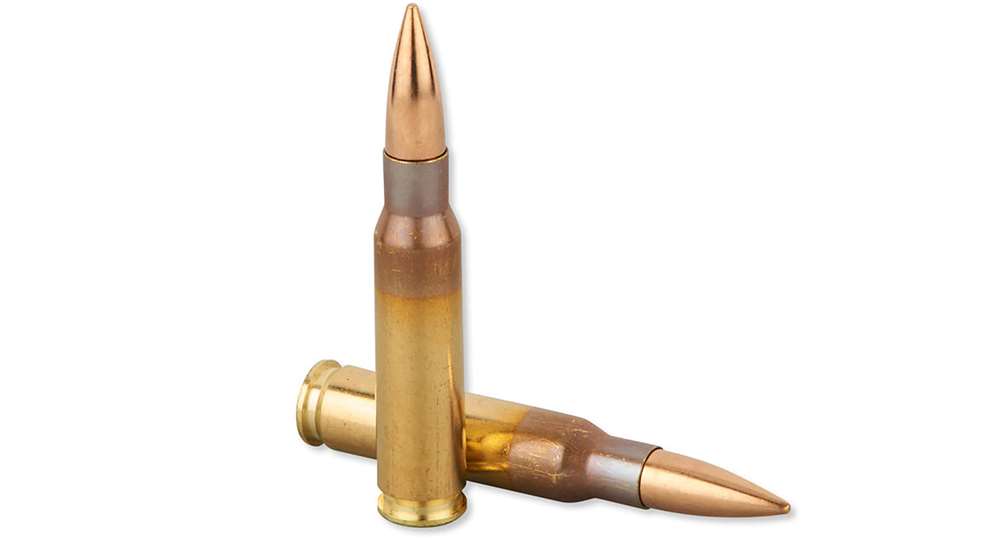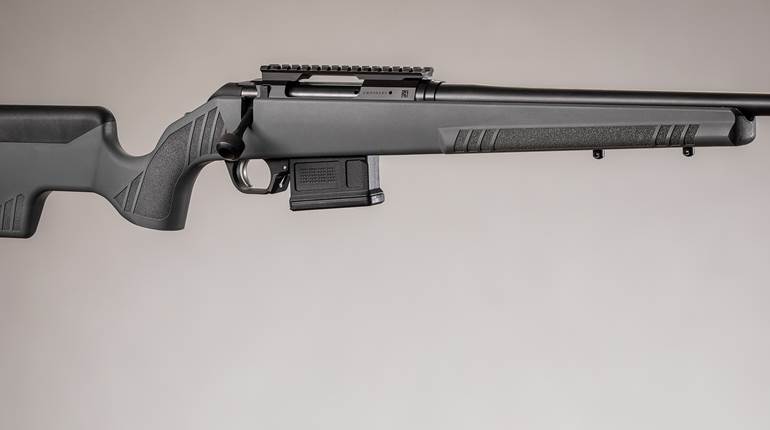
Everyone—and I mean everyone from hunters to marines and soldiers—who have to carry a rifle in the field wants one that weighs next to nothing, is powerful enough to get the job done and doesn’t recoil too much. Of course, these are conflicting parameters, but designers and engineers still attempt to strike a balance between them. This was especially the case with with development of the 7.62x51 mm NATO cartridge and the M14 service rifle by the United States. After World War II, many of the developments from the war, along with lessons learned, were considered and worked into the designs of the next generations of service rifles.
The beginning of the Cold War and the formation of the North Atlantic Treaty Organization (NATO), an alliance of western European nations and the United States against the Soviet Union and its Warsaw Pact puppet-nation allies in eastern Europe, also presented a new logistical issue since many of the NATO allies using different cartridges for their small arms in 1949. Adopting a new, improved cartridge that could be standardized by all NATO allies meant that ammunition logistic issues could be greatly reduced, and also allow the different allied nations to use each other's ammunition. Thus, in the 1950s a new standard rifle cartridge was developed for use by all NATO allies, which would become the 7.62x51 mm NATO cartridges.
As early as the 1940s, experiments utilizing the .300 Savage as a base model were conducted at the Frankford Arsenal. Rather than making these experimental cases from .300 Savage, it was found that an even shorter—ergo lighter—case with less taper could be made by shortening a .30-'06 Sprg. case. The designation of this case was the T65, and a series of experiments continued to provide the data that eventually became the 7.62 mm NATO cartridge.
Beginning with the T65 at 47 mm in length, the T65E1 and T65E2 would be lengthened to 49 mm, each propelling a 147-gr., steel-jacket, lead-core bullet downrange at 2,750 f.p.s. with 2,468 ft.-lbs. of energy. The military would eventually extend the case to 51 mm. Compared to the .30-'06 Sprg., with a 150-grain bullet at 2,910 f.p.s. with 2,820 ft.-lbs. of energy, the T65 series was within spitting distance of the older cartridge. Further refining of the T65 series settled on a 20-degree shoulder angle, presumably for reliable feeding.
 An example of a FN FAL in 7.62x51 mm NATO.
An example of a FN FAL in 7.62x51 mm NATO.
The T44 rifle—a shortened and lighter M1 Garand-based rifle—was designed around the cartridge, and in 1957, the cartridge and rifle were officially adopted as the 7.62x51 mm NATO and M14, respectively. European members of NATO adopted other rifles that fired the cartridge, including the FN FAL (or L1A1 SLR in British nomenclature), the Spanish CETME and a modified version of the CETME made by Heckler & Koch designated as the G3 in Germany.
It became apparent soon after the M14's introduction that, when fired in on the fully automatic setting, the rifles were virtually uncontrollable. Recoil of the 7.62 mm NATO cartridge in the FAL and G3 rifles was also pronounced and violent in select fire. However, the inclusion of a separate grip and butt in alignment with the chamber on those designs resulted in less vertical recoil than on the M14, which used a traditional style of rifle butt and grip. FN and the Springfield Armory added selector locks to their rifles later on, preventing the selector from being put into the automatic setting.
Performance of the round in the U.S. was quite satisfactory, the problem was the delivery platform. More problems came about when the M14 rifle went to Vietnam. Despite being lighter by about 0.75 lbs. than a loaded M1 Garand, the M14 was still too heavy. Add to that, its 22" long barrel was unwieldy in the dense tropical jungles of Southeast Asia. To make matters worse, the original walnut stocks and hand guards of the M14 swelled in the tropical humidity, giving its users fits as zeroes shifted. This was the spur needed to develop fiberglass stocks and handguards as replacements, but it would take a while to iron out all the wrinkles in that technology.
The cartridge wasn’t the problem. Whereas the M14 was—and remains—a high-performing battle rifle, as well as a capable designated marksman rifle in some applications, the conflicts in Vietnam often occurred at much shorter range and often with many more targets to engage. Hence, the U.S. would shortly after adopt the radically different M16 and its smaller 5.56x45 mm NATO cartridge. With that, the 7.62 mm NATO’s role evolved into that as the standard cartridge for battle rifles, medium machine guns, and long-range precision rifles of the time.
 A U.S. M14 service rifle chambered in 7.62x51 mm NATO.
A U.S. M14 service rifle chambered in 7.62x51 mm NATO.
Concurrent with the development of the 7.62 mm NATO cartridge was the idea of a general-purpose machine gun that was more man-portable than the 31-lb. M1919 machine gun that the U.S. had relied on during World War II and Korea. Borrowing heavily from the German design concepts of the general-purpose machine gun, that project culminated with the adoption of the M60 GPMG in 1957, chambered for the 7.62 mm NATO.
The M60 machine gun was an iconic weapon during the Vietnam war, as well as conflicts beyond southeast Asia. It remains in service today, although many units have replaced it with the M249 SAW in 5.56x45 mm NATO or the M240 in 7.62 mm NATO. The cartridge is also the round of choice in the Dillon M134 mini gun, an externally powered (usually by an electric motor) six-barreled Gatling gun that is often mounted on a wheeled vehicle or helicopter.
Because the 7.62 mm NATO was so effective out to ranges of 1,000 meters and more, it was quickly chambered in bolt-action precision sniper rifles, starting with the M40 in 1966 by the Marine Corps. The M40 has undergone some seven design changes and is still used today, although it is being replaced by the Mk 13 Mod 7. Another offshoot sniper rifle is the M24, which uses a full-length action that can be chambered for cartridges as powerful as the .338 Lapua, but it, too, started out in 7.62 mm NATO.
Winchester saw the advantage of a civilian version of the 7.62 mm NATO. In this case, the civilian version beat the military version to the marketplace by a couple of years. In 1952, lightweight rifles were the rage, and Winchester chambered its new cartridge, dubbed the .308 Winchester, in a lighter version of its flagship bolt-action Model 70 Featherweight. The Featherweight had a thin, 22" barrel and lightened stock.
Later the company would chamber what is now called a short-action Models 88 lever-action (1955) and Model 100 semi-auto (1961) in .308 Win. Other manufacturers followed with bolt actions—from virtually every maker of that platform—to lever actions by Browningand Savage, and Remington added a slide-action, as well as a semi-automatic rifle in .308 Win. These sporting rifles have taken game from deer to moose and beyond, the world over.
 An example of a current production Springfield Armory Inc. M1A chambered in .308 Win.
An example of a current production Springfield Armory Inc. M1A chambered in .308 Win.
Handloading the .308 Win. is no different than handloading any standard cartridge. It does not lend itself toward hot-rodding. The only issue I have seen with it was when a sportsman I knew who wanted to get every last bit of usage from his cases had a head separation in his Springfield Armory M1A. He simply kept reloading until the cases separated, usually just ahead of the web.
Most of the time the cases came out easily in two pieces, and my amigo thought he was cutting a fat hog by getting all the use of each case. Then one day during hunting season he brought his precious M1A into me with the front part of the case thoroughly stuck in the chamber. It took me a couple of hours and 30 bucks out of his wallet to finally convince him that checking cases should be part of the reloading process.
Both the 7.62x51 mm NATO and its civilian twin remain a staple of riflemen throughout the western world. There are some reasons for that. First, it’s powerful enough for most applications. Snipers using sophisticated rifles, optics and carefully tailored handloads have scored hits on bad guys out to past 1,300 meters with this cartridge. Sportsmen, too, find it a reliable and accurate cartridge for the game they pursue. Finally, it’s easy to shoot. The 7.62x51 mm NATO/.308 Win. doesn’t pound the shoulder or threaten to dislodge the shooter’s teeth. These qualities, plus the fact that it was—is—a martial cartridge ensures that it will be around for a long time to come.





































